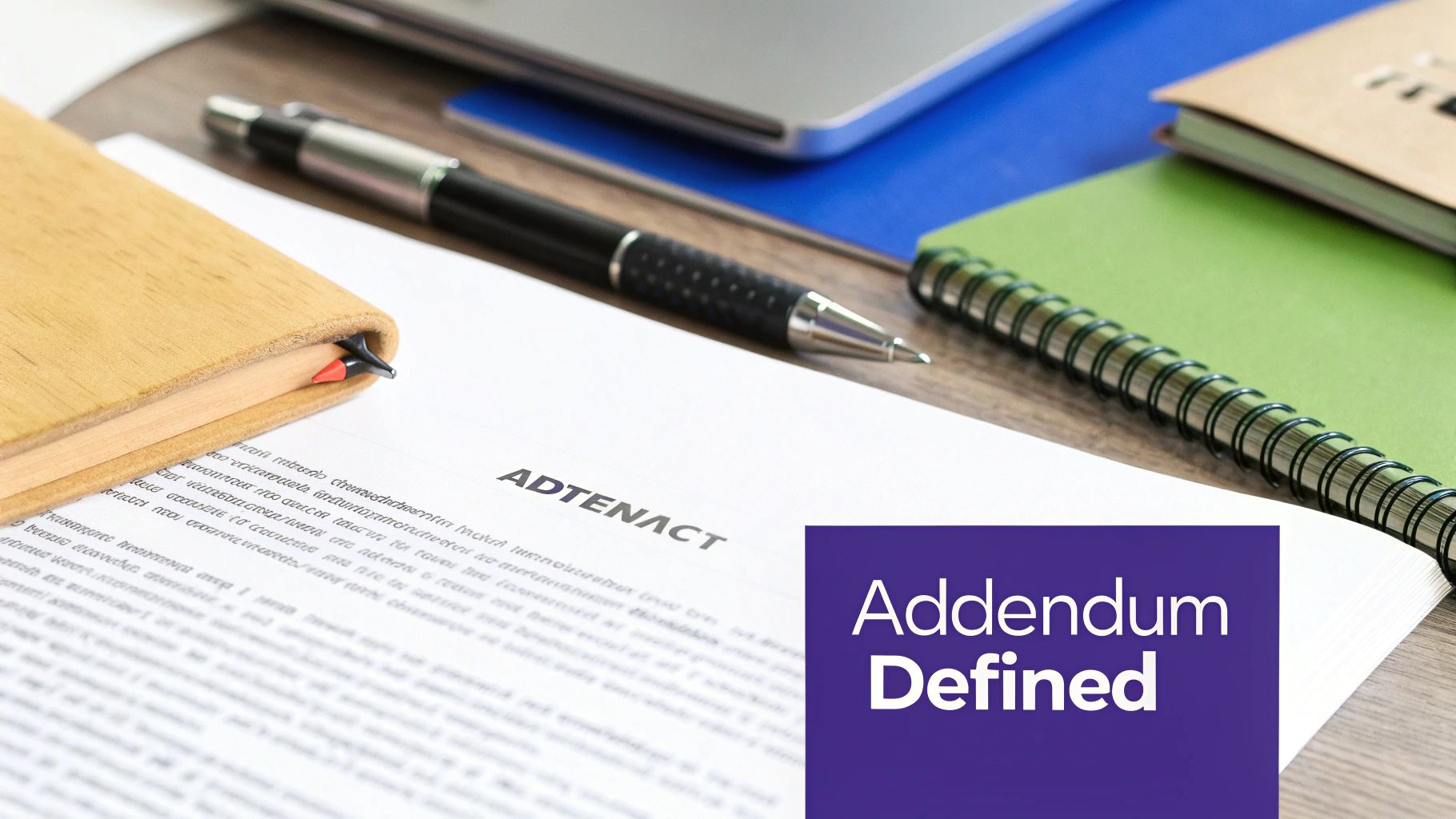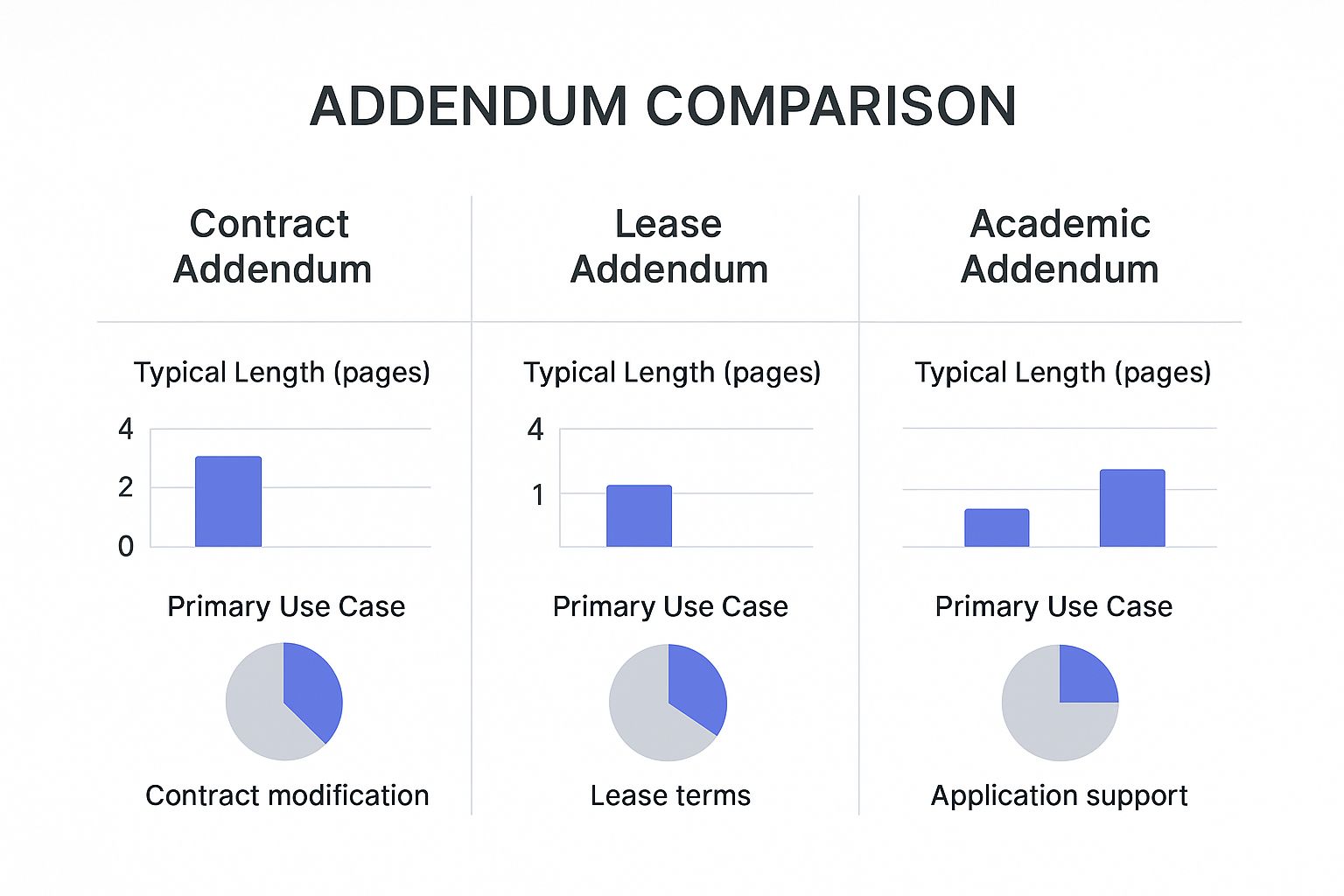
Ever signed a contract, only to realize something was left out? It happens. But you don't need to tear up the old agreement and start from scratch. This is where a contract addendum comes in.
Think of it this way: you've finalized the blueprints for your new house. The foundation is set, and the core design is locked in. Then, you decide you want to add a patio. You wouldn't redraw the entire house plan; you'd simply attach a new drawing—an addendum—for the patio. The original house plan remains the same, but now it has a new, officially recognized part. That’s exactly what an addendum does for a contract.

What Exactly Is a Contract Addendum?
So, what is an addendum in practical, legal terms? It's a brand-new document you attach to an existing, signed contract to introduce new information or terms. Its sole job is to add something, not change what’s already there. This is a crucial point—it supplements the original agreement, leaving the initial terms untouched.
The word "addendum" literally comes from the Latin phrase for "that which is to be added," which perfectly sums up its purpose. Once all parties agree to and sign the addendum, it becomes a legally binding part of the original contract.
Clarifying the Role of an Addendum
This little document is a lifesaver when things change or new details emerge after everyone has already signed on the dotted line. For example, imagine a homebuyer and seller sign a purchase agreement. A week later, they agree that the seller will leave behind the custom-built shelving in the garage. An addendum is the perfect tool to make that new agreement official and legally binding without messing with the original purchase contract.
Addenda are incredibly common because business and life are dynamic. Their use skyrocketed during the COVID-19 pandemic, with one report showing that 72% of renegotiated contracts included an addendum to handle new realities like remote work clauses or supply chain issues. In the U.S. real estate market alone, the National Association of Realtors (NAR) reported over 4.2 million addenda were filed in 2022, showing just how vital they are.
An addendum is all about clarity and prevention. It ensures everyone is on the same page about new terms, creating a clear, documented record. This simple step can prevent massive headaches and costly disputes down the road.
Getting the hang of when and how to use an addendum is a key part of smart contract management. If you want to dive deeper into the legal specifics, our guide on the addendum meaning in law is a great next step.
For a quick reference, here’s a table that breaks down the essential characteristics of an addendum.
Quick Guide to Understanding an Addendum
This table summarizes the core purpose and function of a contract addendum, making it easy to see how it works at a glance.
| Characteristic | Description |
|---|---|
| Purpose | To add new terms, details, or clarifications to an existing contract. |
| Timing | Created and signed after the original contract is already executed. |
| Legal Effect | Becomes a legally binding part of the original agreement. |
| Core Principle | It supplements the contract without altering the original, agreed-upon text. |
In short, an addendum is a straightforward and powerful tool for keeping your contracts up-to-date without the hassle of starting over.
Addendum vs. Amendment: What’s the Real Difference?
It’s a common point of confusion, but mixing up an addendum and an amendment can lead to messy legal disputes. While they sound alike, their roles in contract management are fundamentally different. The key distinction all comes down to when and how they interact with an original agreement.
Think of it this way: An addendum is like a bonus track on a finished album. It adds brand-new content that wasn’t part of the original recording but is now officially part of the package. An amendment, on the other hand, is like a remix—it takes the original track and changes it directly.
Simply put, an addendum adds something new, while an amendment alters something that’s already there.
Addendum vs. Amendment Key Distinctions
To make the choice crystal clear, let's break down the functional and legal differences between these two important documents. This table will help you see exactly when to use an addendum and when you need an amendment.
| Feature | Addendum | Amendment |
|---|---|---|
| Purpose | Adds new terms, conditions, or information to an existing contract. | Changes, corrects, or deletes existing terms within a contract. |
| Timing | Created at the same time as the original contract or shortly after, before all parties have fully executed their obligations. | Created after the original contract is already signed and in effect to modify its terms. |
| Function | Supplements the original agreement without altering its existing text. It's a separate, new document. | Directly alters the text of the original agreement. It changes the original deal. |
| Common Use | Including a financing contingency in a real estate offer; adding an exhibit or schedule. | Changing a closing date; adjusting a payment amount or deadline. |
Understanding these distinctions is crucial for maintaining the integrity of your agreements and avoiding confusion down the line.
Choosing the Right Tool for the Job
So, how does this play out in the real world?
Imagine you’ve just signed a contract with a freelance graphic designer to create a new company logo. A week later, you realize you also need them to design a set of matching business cards. This is the perfect time for an addendum. You’d draft a new document that outlines the scope for the business cards—deliverables, timeline, and payment—and attach it to the original contract. The original logo agreement remains completely untouched.
Now, let's say you wanted to change the payment deadline for the original logo project, moving it up from 30 days to 15 days. For that, you’d need an amendment. This change directly alters a specific clause within the existing contract. For any change like this to be legally binding, both parties must agree to it. You can learn more about the importance of mutual agreement in our guide on what is a consideration in a contract.
The core principle is simple: use an addendum to add and an amendment to alter. This simple rule prevents ambiguity and keeps your original agreement intact.
This preference for adding over altering is common in business. A review of Fortune 500 companies found that legal teams drafted an average of 12.7 addenda per 100 contracts, compared to just 8.3 amendments. But this comes with a warning: poorly drafted addenda are a source of conflict. About 11% of corporate legal disputes stem from addenda with vague language or unclear consent.
Addenda in Different Contexts
The purpose and structure of an addendum can change quite a bit depending on where it’s being used, from a real estate deal to a college application.
This infographic breaks down what an addendum typically looks like in different fields.

As you can see, contract and lease addenda are usually short and to the point, focusing on specific legal details. Academic addenda, however, can be much longer because they often need to provide significant context or supplementary information. Knowing these nuances helps you draft the right document for your situation, ensuring everything is clear, correct, and legally sound.
Why a Contract Addendum Has Legal Power

An addendum isn't just an informal note you staple to a contract; it's a formal document that carries real legal weight. But what gives this separate piece of paper the power to become a fully enforceable part of a larger agreement? The answer is all in how it’s created and connected to the original deal.
Think of your original contract as the foundation of a house. The addendum is like building a new, official room onto it. Once it's properly attached and signed off, it becomes part of the house's structure, just as if it had been there from the beginning. Legally, this is called being "incorporated by reference," and it's what allows an addendum to cleanly add new terms, fix vague language, or address new situations without having to tear down the whole house and start over.
It’s a clean, efficient way to let an agreement evolve.
The Foundation of Legal Validity
For an addendum to actually work and hold up in court, it has to do more than just exist. It needs specific ingredients that prove everyone agreed to the changes and that it’s clearly tied to the first contract. Without these, it's just a piece of paper with some ideas on it. It must function like a mini-contract that formally attaches itself to the main one.
The key elements are a clear title, a direct reference to the original contract (including its date and the people involved), and of course, a description of the new terms. Most importantly, it needs signatures from every single person who signed the original document. This mutual consent is what makes it stick. In fact, failing to get all the right signatures is a critical mistake seen in about 15% of disputed contract cases, often making the addendum completely useless. You can get more details on these formalities in this helpful guide on addendum requirements.
A properly drafted addendum does more than just add information; it legally binds all parties to the new terms as if they were included in the original contract from day one. It is a tool for precision and adaptability.
Essential Components for an Enforceable Addendum
To make sure your addendum has the legal muscle it needs, you have to draft it carefully. Missing even one small detail can create a loophole that defeats the whole purpose. Here are the non-negotiable parts every addendum must have:
- Clear Identification: The document needs to be clearly labeled "Addendum to Contract" or something similar. This immediately tells everyone what it is and what it’s for.
- Reference to Original Contract: It must name the original contract by its title, date, and the parties involved. This creates an undeniable link that ties the two documents together.
- Mutual Consent: All the original parties must sign and date the addendum. Their signatures are the proof that everyone has read, understood, and agreed to the new terms.
- The "In Full Force" Clause: This is a crucial sentence stating that all other terms of the original agreement that aren't changed by the addendum remain in "full force and effect." This simple clause prevents anyone from claiming the addendum accidentally voided the rest of the contract.
By including these components, you transform a simple document into a powerful legal tool, ensuring your agreement can adapt correctly while remaining fully enforceable.
When to Use an Addendum in the Real World
Theory is one thing, but seeing how an addendum works in the real world is where it all clicks. An addendum’s true power is its ability to solve everyday problems cleanly and legally. Think of it as the go-to tool for adding new information to a finished contract without having to tear the whole thing up and start over.Let's say you're selling your house. The purchase agreement is signed, sealed, and delivered. Then, the buyer decides they absolutely love your brand-new washing machine and wants it included in the sale. Instead of rewriting a massive contract, you just create a simple, one-page addendum. It clearly states the washing machine stays, both parties sign, and it's officially part of the deal.
It’s an elegant fix for a last-minute change that prevents confusion and keeps everything legally sound.
Common Scenarios for Using an Addendum
The real beauty of an addendum is its flexibility. It’s useful in countless industries and personal situations, adapting to new terms or unexpected events that pop up after an agreement is already finalized.
Here are a few practical examples of when an addendum is the perfect tool:
- Real Estate Transactions: A home inspection reveals a few issues, and the seller agrees to make specific repairs after the contract was signed. An addendum can spell out exactly what will be fixed, the deadline for completion, and who is paying for it.
- Lease Agreements: A tenant wants to get a dog, but the original lease has a strict no-pet policy. The landlord can issue a "Pet Addendum" that lays out the rules, pet deposit, and any extra fees, making it an official part of the lease agreement.
- Freelance Contracts: Your client loves the website you designed and now wants you to create a set of matching social media graphics. An addendum can specify these new deliverables, the additional fee, and a new timeline without messing with the original website contract.
These situations show how seamlessly an addendum can integrate new agreements. But it's crucial to draft these documents with precision to head off any future problems. If a disagreement ever pops up over the new terms, a well-written addendum is your best defense. Our guide on effective contract dispute resolution offers more tips for navigating those situations.
The primary goal of an addendum is to formalize new agreements that arise after a contract is signed. It ensures that verbal promises or new negotiations are officially documented and legally enforceable.
Addenda in Large-Scale Projects
The importance of an addendum becomes crystal clear in high-stakes environments like construction and public procurement. In these fields, something unexpected is bound to happen—it's the norm, not the exception. A recent World Bank Procurement Report revealed that 58% of infrastructure contracts over $100 million used at least one addendum. These massive projects averaged 3.2 addenda each, covering everything from design tweaks to new environmental rules. You can learn more about how these crucial documents impact major projects and their lifecycles.
This shows that addenda aren't just for small tweaks. They are a fundamental tool for helping huge projects adapt to changing realities while keeping the legal foundation solid. They provide much-needed flexibility without weakening the original agreement.
How to Write an Addendum That Holds Up

So, you need to add something to an existing contract. The good news is, creating a legally solid addendum isn't about mastering complex legalese. It's really about following a clear, logical process. A well-crafted addendum should feel like a natural extension of the original agreement, leaving no room for confusion down the road.
Think of it like adding a new room onto a house. You can't just nail some boards together and hope for the best. You need to connect it properly to the existing foundation (the original contract) and make sure the new structure is sound (the new terms). If you cut corners, the whole thing could fall apart.
Essential Components of an Enforceable Addendum
To make sure your addendum is legally binding and crystal clear to everyone, you need to include a few key elements. Each one plays a specific role in formally tying the new terms to the original agreement and heading off future arguments. A sloppy or incomplete addendum is often worse than none at all, as it just creates more ambiguity.
Here’s a simple checklist to guide you through it:
Use a Clear Title: Don't get creative here. Start with a straightforward heading like "Addendum to Employment Agreement" or "Addendum 1 to Purchase Contract." This immediately tells everyone what they're looking at.
Reference the Original Contract: This is the most critical step. You have to explicitly identify the original agreement by its full title, the date it was signed, and the full legal names of everyone who signed it. This is what officially "bolts" the addendum onto the main contract.
Use Clear and Precise Language: Describe the new terms or information with as much detail as possible. Avoid vague words that could be interpreted in different ways later on. If you're adding a new service, for example, spell out the exact scope, deadline, and payment terms.
Include a Reaffirmation Clause: This is a simple but powerful statement confirming that all other terms of the original contract are still in effect. It's a safety net that prevents anyone from arguing that the addendum somehow canceled out other parts of the deal. A common phrase is: "All other terms and conditions of the original agreement not modified herein shall remain in full force and effect."
An effective addendum leaves no doubt about its connection to the original contract or the nature of the new terms. Its strength lies in its clarity, precision, and the documented consent of all parties.
Finalizing the Addendum for Legal Effect
Drafting the document is only half the battle. An unsigned addendum is just a piece of paper with suggestions—it has no legal weight. To make it official, you have to get it signed by every single person who signed the original contract.
This means every party must sign and date the addendum. Those signatures are the undeniable proof of mutual consent, showing that everyone has read, understood, and agreed to the changes. Without those dated signatures, the addendum is powerless and won't hold up in a dispute.
Finally, make sure everyone gets a fully signed copy for their records. This ensures all parties have the same official document and prevents any "he said, she said" arguments later.
Common Questions About Contract Addenda
Even after you get the hang of what an addendum is, a few practical questions almost always pop up. It’s one thing to know the definition, but another to feel confident when you’re actually dealing with one. Let's tackle the most common uncertainties people have so you're ready for the real world.
Here are the key questions that come up time and time again.
Can You Add an Addendum Without Everyone's Agreement?
That’s a hard no. An addendum is a team sport, not a solo move. Just like the original contract couldn't be created without everyone on board, an addendum needs the signature of every single party from that initial agreement to be legally binding.
Think about it—if one person could just tack on a new clause after the fact, it would completely defeat the purpose of having a mutual agreement in the first place. The legal weight of an addendum comes directly from that shared consent. Without it, the document is just a piece of paper with no real power. This idea of mutual agreement is the absolute foundation of contract law.
What Happens if an Addendum and the Contract Conflict?
This is where a little bit of careful drafting can save you a massive headache down the road. Generally speaking, if there’s a direct conflict between a term in the original contract and a term in a properly signed addendum, the addendum wins. The whole point of it is to introduce a new, specific agreement that overrides the old one on that particular issue.
Key Takeaway: Courts usually see the addendum as the most recent statement of what everyone intended, so it takes priority over any conflicting part of the original deal.
But—and this is a big but—relying on that general rule can lead to expensive and frustrating legal battles if the language isn't crystal clear. The absolute best practice is to spell it out. State explicitly in the addendum which clause of the original contract you’re changing or replacing. That precision leaves no room for doubt and keeps everyone on the same page.
Is There a Limit on How Many Addenda a Contract Can Have?
Legally, no. You can attach as many addenda as you need to a single contract. As a project or relationship evolves over time, you might find it necessary to add several new agreements. A long-term service contract, for example, could easily pick up a few addenda as you add new services or tweak the terms.
From a practical standpoint, though, things can get messy. If a contract has a dozen attachments, it becomes a nightmare to track everyone’s obligations. In those situations, it’s often much smarter to consolidate everything. You can create a single, new "amended and restated agreement" that replaces the original contract and all its addenda, giving you one clean document to work from.
How Do E-Signatures Work for Addenda?
Electronic signatures are perfectly valid and legally binding for addenda, just as they are for the contracts themselves. Thanks to laws like the ESIGN Act in the United States, an e-signature has the same legal force as a traditional pen-and-ink "wet signature."
When you're using e-signatures for an addendum, it’s a good idea to use a secure and well-known platform. These services provide a clear audit trail showing who signed, when they signed, and from where. This adds an extra layer of security and proof, ensuring that the mutual consent needed for the addendum is clearly and legally recorded for everyone involved.
Navigating contracts can be complex, but it doesn't have to be. Legal Document Simplifier uses powerful AI to instantly translate dense legal documents into clear, easy-to-understand summaries. Highlight key terms, track deadlines, and identify risks without the high cost of legal consultations. Try it today and make smarter, faster decisions with confidence. Learn more at Legal Document Simplifier.